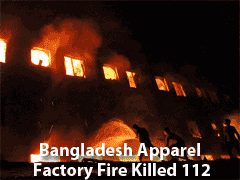From SCDigest's On-Target e-Magazine
- Jan. 9, 2013 -
Supply Chain News: Deadly Apparel Factory Fires in Pakistan and Bangladesh Once Again Highlight Offshore Sourcing Risks – and Potential Value of Risk Monitoring Services
Can Procurement Managers Control Risks Associated with Sub-Contracting? Ethical Sourcing - or the Low Price?
SDigest Editorial Staff
The last few months of 2012 were unfortunately marred by two deadly fires at offshore apparel factories used as suppliers by prominent Western companies, tragedies that are likely to spur changes in sourcing practices and regulations - and perhaps further spur corporate interest in obtaining better and more timely supply chain risk-related information.
In early September, a fire erupted at an apparel factory complex in Karachi, Pakistan, killing more than 300 workers there. Many of them died because exit doors from the shop floor were not available, or were padlocked and windows barred, blocking escape routes.
SCDigest Says: |
 |
Some observers say that large US and European retailers know full well their original orders are being outsourced through the middlemen they use, and what drives the deal is overwhelming the ability to deliver the volumes required at the lowest price.
|
|
What Do You Say?
|
|
|
|
The story grew even more tragic when information came to light that in August, that factory complex had received the prestigious SA8000 certification from inspectors working for Social Accountability International, a non-profit monitoring group based in New York that obtains much of its financing from corporations and relies on affiliates around the world to do most of its inspections. To receive that certification, facilities must meet international standards in nine areas, including health and safety, child labor and minimum wages.
Western companies will use such certifications as evidence that they are ethically sourcing. Obviously in this case, the inspectors must not have done a very thorough job, with bribes certainly another possibility.
The New York Times said that "The Karachi tragedy is a huge embarrassment to the factory monitoring system," and the event caused many others to question whether corporate-sponsored groups can really well monitor conditions at suppliers. Another example of such groups is the Fair Labor Association, an organization started primarily with funding from the apparel industry, and which gained prominence in early 2012 when it was hired by Apple to audit conditions at some of its contract manufacturing sites.
"We're trying to find out what went wrong," Eileen Kohl Kaufman, executive director of Social Accountability International, said in an interview shortly after the deadly fire.
About the same time, Richard Locke of MIT'S Sloan School of Management, said that "Even after a decade or more of such private monitoring efforts, these programs, no matter how well funded or designed or how well trained their auditors are, simply do not in and of themselves produce sustained and significant improvements in labor standards in most supply chain factories."
Critics also say that factory owners and managers are usually informed of the inspection visits before they happen, giving them time to hide dirty laundry and to coach employees about what answers to give.
Then in November, an eerily similar fire at an apparel factory in Bangladesh, which killed at least 112, a total again dramatically escalated because of a lack of escape routes and locked doors and windows.
This time, a number of prominent customers being supplied by the company were named, and included major retailers as Sears, European chain C&A, and, it turns out, Walmart, among many others. Walmart later stated that the factory was not on its approved list," but the garment work went there anyways after an approved supplier subcontracted the work to the fatal factory. Sears also said it did not know the factory was one of its apparel sources.
Bangladesh has been growing its apparel export business rapidly, using low prices to grab global market share. But that means many manufacturers are cutting any corner they can to turn a profit, with safety being a common area of neglect.
 That was certainly the cases at Tazreen Fashions Ltd, where the New York Times says "Fire safety preparations were woefully inadequate. The building itself was under construction — even as sewing work continued inside — and mounds of flammable yarn and fabric were illegally stored on the ground floor near electrical generators." The factory did not have ceiling sprinklers or an outdoor fire escape for upper levels of the facility. That was certainly the cases at Tazreen Fashions Ltd, where the New York Times says "Fire safety preparations were woefully inadequate. The building itself was under construction — even as sewing work continued inside — and mounds of flammable yarn and fabric were illegally stored on the ground floor near electrical generators." The factory did not have ceiling sprinklers or an outdoor fire escape for upper levels of the facility.
Tarzeen had in fact been faulted for violations during inspections conducted on behalf of Walmart and and the Business Social Compliance Initiative, a European organization similar to the Social Accountability International.
The factory's owner said a team from Walmart's local office conducted a compliance audit last year and cited the factory for excessive overtime, but did not mention of fire safety or other issues.
Still, the work kept coming, often through sub-contracting.
(Sourcing and Procurement Article Continues Below)
|